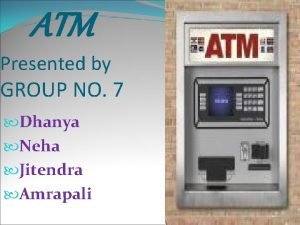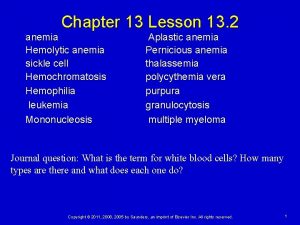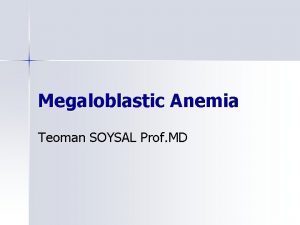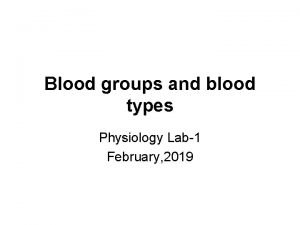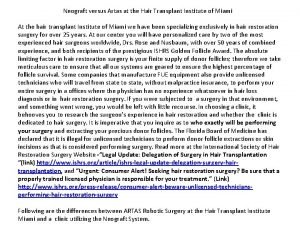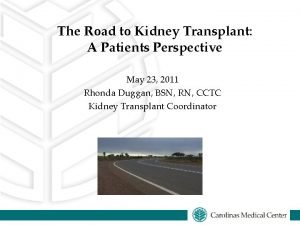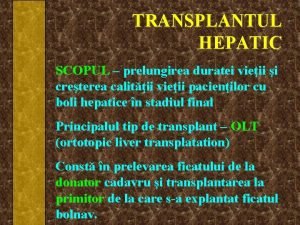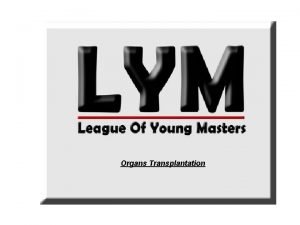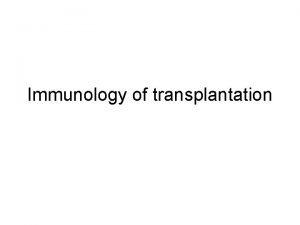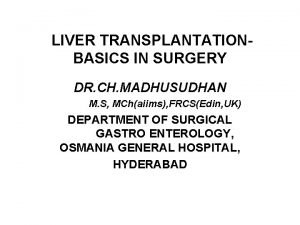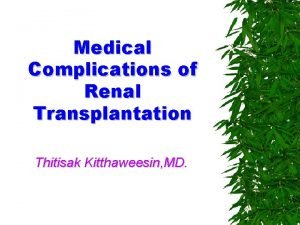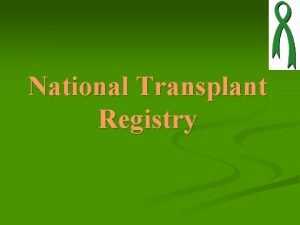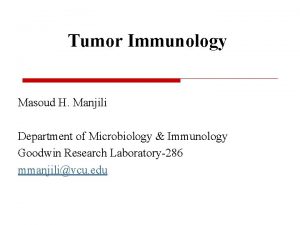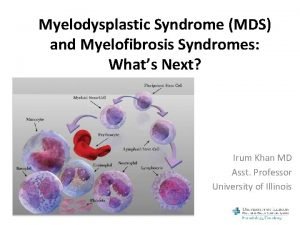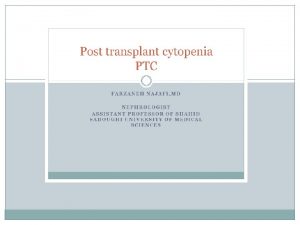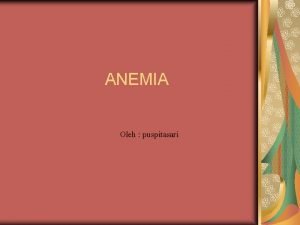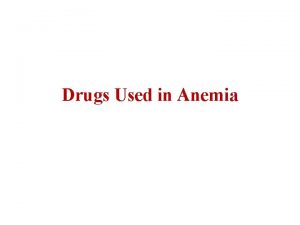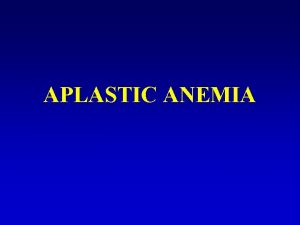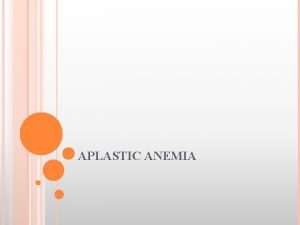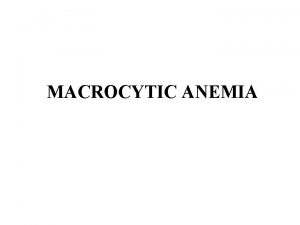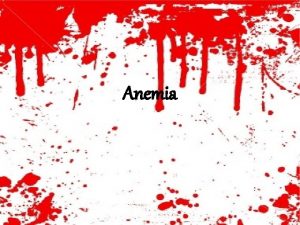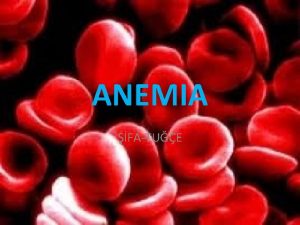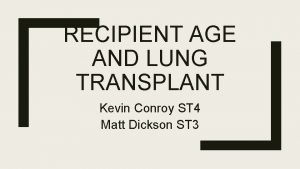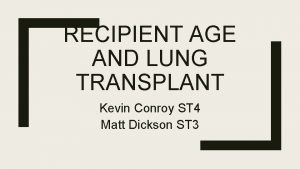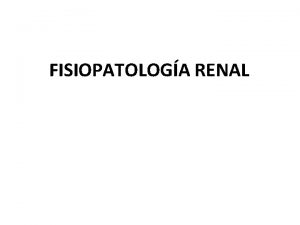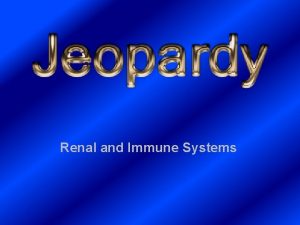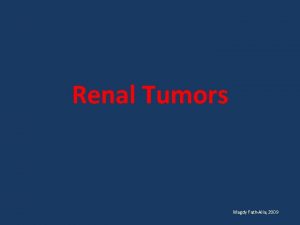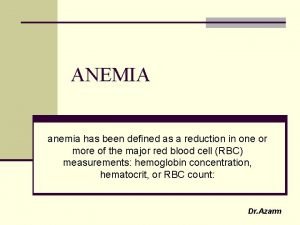Anemia in a renal transplant recipient Dr Dhanya

























- Slides: 25


Anemia in a renal transplant recipient Dr. Dhanya Mohan MD DNB MRCP (UK) Department of Nephrology Dubai Hospital

History • • • 34 year old Arab male Type 1 DM for 13 years Hypertension for 3 years Diabetic retinopathy and nephropathy CKD Stage 5, Dialysis dependent since Aug 2010 Feb 2011: Travelled to China, underwent LURD renal transplantation • Received ATG as the induction agent • Maintained on Pred 5 mg od Tacrolimus 2 mg bd MMF 750 mg bd

History • Received Valganciclovir and Septrin prophylaxis • Continued follow up in our Nephrology Clinic, with baseline S. creatinine: 1. 1 -1. 3 mg/ dl • October 2012: detected to have anemia, Hb: 8 gm/ dl – Previous Hb: 13. 3 gm/ dl July 2012 – Admitted for further evaluation – No history of blood loss – No jaundice, skin bleeds – No fever or skin rash

On examination • • • Pallor present No lymphadenopathy CVS: S 1 S 2 normal RS: Clear P/A: Soft, allograft in RIF. Liver, spleen: Not palpable

Anemia in a renal transplant recipient, normal renal function • Iron deficiency • Drug induced: Myelosuppressive effect of MMF Tacrolimus toxicity • Blood loss • Viral infections

Investigations • • • Hb: 8 gm/ dl 7. 3 gm/ dl MCV: 80 fl WBC: 3, 500/ cc Plts: 2, 12, 000/ cc Retics: 0. 4 % (Normal: 0. 2 -2 %) Blood film: Normocyctic normochromic anemia. Mild leucopenia consistent with bicytopenia. • Creatinine: 1 mg/ dl • Urea: 52 mg/ dl • LFT: normal Tacrolimus level: 7 ng/ ml

Evaluation of differentials • • Iron studies: Normal Vitamin B 12, folate: Normal CMV DNA PCR: negative Stool Occult Blood: Positive

UGI Scopy: • • • Erosive pre-pyloric gastritis Angiodysplasia of stomach H. pylori: negative Colonoscopy: Normal Patient was discharged on Pantoprazole and Inj. Darbepoetin 60 mcg once per week

Further course • Recurrent anemia: received five units of Packed RBC during the next four months, recurrent anemia • Advised bone marrow examination multiple times, but unwilling • March 2013: evaluated elsewhere • BM examination report: • Myeloid : erythroid ratio: 4: 1 • Complete myeloid maturation, no increase in blasts • Decreased erythroid cells with giant pronormoblasts?

Further course. . • Retics: 0. 17% • Keeping in mind persistent reticulocytopenia with refractory anemia, diagnosed to have Pure red cell aplasia • Parvovirus B 19 infection suspected • Parvovirus serology and DNA PCR requested • Parvovirus Ig M: positive • Parvovirus Ig G: positive • Parvovirus DNA PCR: positive

Diagnosis • Pure Red Cell Aplasia secondary to Parvovirus B 19 infection

Parvovirus B 19 • Small, non enveloped, single stranded DNA virus • Parvovirus family, erythrovirus genus • 1975 • Pronounced tropism for erythroid precursor cells

Parvovirus B 19 • Infection very common • 70 -85% serologic evidence of past infection • Transmission occurs by inhalation of virus in aerosol droplets • Vertical transmission, transfusion of blood and blood products • Targets the erythroid progenitor cells in BM by binding to the glycosphingolipid globoside • Clearance: humoral immune response

Complications – Well established syndromes • • • Fifth disease / erythema infectiosum Arthropathy Hydrops fetalis, IUD, Miscarriage Transient aplastic crises Chronic pure red cell aplasia – in immunocompromised patient


Manifestations in renal transplant patients System Manifestation Hematologic Acute anemia Chronic pure red cell aplasia Leukopenia, thrombocytopenia, pancytopenia Renal Transient allograft dysfunction Acute allograft rejection Collapsing glomerulopathy Thrombotic microangiopathy Hepatobiliary Acute hepatitis Fibrosing cholestatic hepatitis Neurologic Encephalitis Cerebral angitis

Co-infection with herpes viruses • CMV infection/ HHV 6 • Co infection can enhance the pathogenicity and complications related to each individual virus

Diagnosis • Serology: Ig M/ Ig G • DNA PCR: • BM examination: giant pronormoblasts

Treatment • Reduction or discontinuation of immunosuppression • Change of immunosuppression (tacrolimus to cyclosporine) • IV immunoglobulin alone • Combination of IV immunoglobulin and reduced immunosuppression • Conservative therapy, with transfusion and /or erythropoetin

IV Immunoglobulin • • Important source of anti B 19 antibodies 400 mg/ kg/ day for 5 -10 consecutive days Mean time to hemoglobin recovery: 3. 9 weeks ADR: – Fever, chills, headache, myalgia, hypertension, chest pain – AKI: Sucrose for IV Ig stabilisation

How did we treat him? • • • Reduced Mycophenolate to 250 mg bd Tacrolimus to 2 mg -0 - 1 mg IV Ig 400 mg/ kg for 5 days Wt: 80 Kg 30 gm IV Ig over 4 hours

Treatment • 3 rd day: Fever, chills, malaise…IV Ig withheld for one day, and then the course completed • On discharge, Hb: 8. 4 gm/ dl. WBC: 4200/cc, Plts: 225000/cc • May 2013: Clinic visit: Hb: 13. 2 gm/ dl, Parvovirus DNA PCR: Neg • 3 year follow up: Hb: stable, Parvovirus DNA PCR: Positive, 375 copies/ ml

Take home message • Renal transplant patients can develop symptomatic B 19 infections as a result of primary infection or because of reactivation of latent or persistent viral infection • Pure red cell aplasia manifesting as chronic anemia is the most common presentation of B 19 infection in immunocompromised patients • Other cytopenias & collapsing glomerulopathy and thrombotic microangiopathy are associated with B 19 infection in renal transplant recipients • In KTRs, serologic tests should be supplemented by a PCR to detect viral DNA • Treatment with IV Ig and/ or minimization of immunosuppression can effectively combat B 19 infection

Thank you for your attention!
 Res extra commercium
Res extra commercium Sindrome nefrótica
Sindrome nefrótica Dhanya atm
Dhanya atm Vasa recta vs peritubular capillaries
Vasa recta vs peritubular capillaries Pernicious anemia vs megaloblastic anemia
Pernicious anemia vs megaloblastic anemia Megaloblastic anemia laboratory findings
Megaloblastic anemia laboratory findings Lesch nyhan syndrome
Lesch nyhan syndrome Blood group matching chart
Blood group matching chart Place stamp here
Place stamp here A gift bestowed to influence a recipient's conduct:
A gift bestowed to influence a recipient's conduct: It is a gift bestowed to influence a recipient’s conduct.
It is a gift bestowed to influence a recipient’s conduct. Which medal of honor recipient is described
Which medal of honor recipient is described Why is type ab a universal recipient
Why is type ab a universal recipient Leukemoid reaction
Leukemoid reaction Neograft miami
Neograft miami Disadvantage of kidney transplant
Disadvantage of kidney transplant Citomegalvirus
Citomegalvirus Face transplant
Face transplant Types of transplantation
Types of transplantation Heterotopic liver transplant meaning
Heterotopic liver transplant meaning Intraosseous
Intraosseous National transplant registry malaysia
National transplant registry malaysia Slk criteria
Slk criteria Face transplant
Face transplant Oncogens
Oncogens Next
Next


